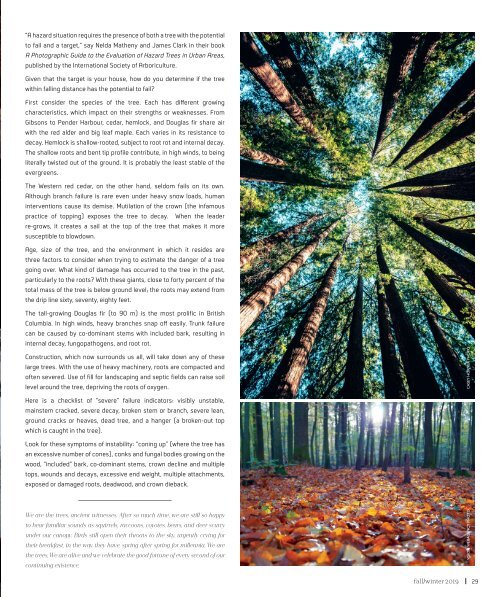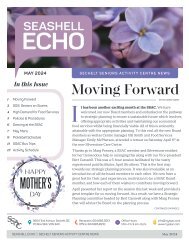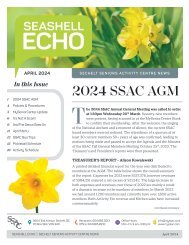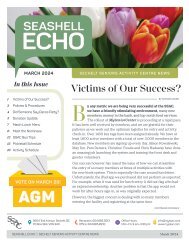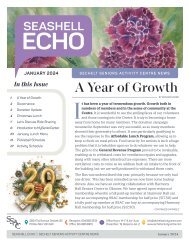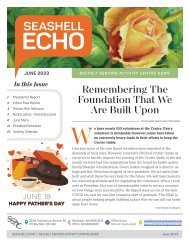ZOOM | Fall/Winter 2019
A magazine showcasing the natural beauty of the Sunshine Coast of British Columbia, Canada - its people, spectacular scenery, coast lifestyle and vibrant arts scene.
A magazine showcasing the natural beauty of the Sunshine Coast of British Columbia, Canada - its people, spectacular scenery, coast lifestyle and vibrant arts scene.
You also want an ePaper? Increase the reach of your titles
YUMPU automatically turns print PDFs into web optimized ePapers that Google loves.
“A hazard situation requires the presence of both a tree with the potential<br />
to fail and a target,” say Nelda Matheny and James Clark in their book<br />
A Photographic Guide to the Evaluation of Hazard Trees in Urban Areas,<br />
published by the International Society of Arboriculture.<br />
Given that the target is your house, how do you determine if the tree<br />
within falling distance has the potential to fail?<br />
First consider the species of the tree. Each has different growing<br />
characteristics, which impact on their strengths or weaknesses. From<br />
Gibsons to Pender Harbour, cedar, hemlock, and Douglas fir share air<br />
with the red alder and big leaf maple. Each varies in its resistance to<br />
decay. Hemlock is shallow-rooted, subject to root rot and internal decay.<br />
The shallow roots and bent tip profile contribute, in high winds, to being<br />
literally twisted out of the ground. It is probably the least stable of the<br />
evergreens.<br />
The Western red cedar, on the other hand, seldom fails on its own.<br />
Although branch failure is rare even under heavy snow loads, human<br />
interventions cause its demise. Mutilation of the crown (the infamous<br />
practice of topping) exposes the tree to decay. When the leader<br />
re-grows, it creates a sail at the top of the tree that makes it more<br />
susceptible to blowdown.<br />
Age, size of the tree, and the environment in which it resides are<br />
three factors to consider when trying to estimate the danger of a tree<br />
going over. What kind of damage has occurred to the tree in the past,<br />
particularly to the roots? With these giants, close to forty percent of the<br />
total mass of the tree is below ground level; the roots may extend from<br />
the drip line sixty, seventy, eighty feet.<br />
The tall-growing Douglas fir (to 90 m) is the most prolific in British<br />
Columbia. In high winds, heavy branches snap off easily. Trunk failure<br />
can be caused by co-dominant stems with included bark, resulting in<br />
internal decay, fungopathogens, and root rot.<br />
Construction, which now surrounds us all, will take down any of these<br />
large trees. With the use of heavy machinery, roots are compacted and<br />
often severed. Use of fill for landscaping and septic fields can raise soil<br />
level around the tree, depriving the roots of oxygen.<br />
Here is a checklist of “severe” failure indicators: visibly unstable,<br />
mainstem cracked, severe decay, broken stem or branch, severe lean,<br />
ground cracks or heaves, dead tree, and a hanger (a broken-out top<br />
which is caught in the tree).<br />
Look for these symptoms of instability: “coning up” (where the tree has<br />
an excessive number of cones), conks and fungal bodies growing on the<br />
wood, “included” bark, co-dominant stems, crown decline and multiple<br />
tops, wounds and decays, excessive end weight, multiple attachments,<br />
exposed or damaged roots, deadwood, and crown dieback.<br />
CASEY HORNER PHOTO<br />
We are the trees, ancient witnesses. After so much time, we are still so happy<br />
to hear familiar sounds as squirrels, raccoons, coyotes, bears, and deer scurry<br />
under our canopy. Birds still open their throats to the sky, urgently crying for<br />
their breakfast, in the way they have, spring after spring for millennia. We are<br />
the trees. We are alive and we celebrate the good fortune of every second of our<br />
continuing existence.<br />
VISION WEBAGENCY PHOTO<br />
fall/winter <strong>2019</strong> 29


